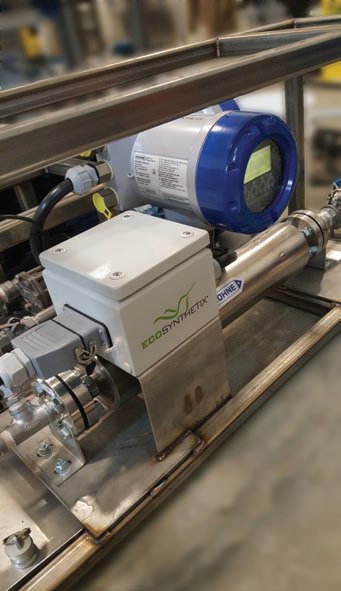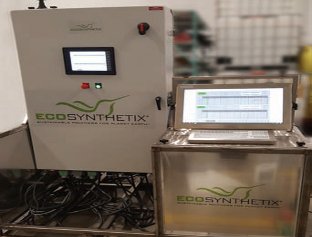What’s so tough about formaldehyde-free?
19 May 2017No Added Formaldehyde, or NAF, has been hard for manufacturers to achieve without penalising productivity or quality. Bio-engineering at last offers a practical solution. Jeff MacDonald, chief executive officer of EcoSynthetix, explains how DuraBind is a binder whose time has come
At the heart of all wood compositebased products is the binder system – the chemistry used to hold wood chips together. Over the past several years, the quest for alternative, formaldehyde-free, or no-added-formaldehyde (NAF), renewable wood binders has been the subject of intense interest and development.
Several alternatives have been proposed. However, technological development has not fully optimised the binding potential of most of these NAF options for all types of wood composite applications. This has prevented their widespread use.
Of the many alternatives to formaldehyde binders, pMDI-based resins – that is, those based on polymeric MDI – have gained the greatest acceptance, particularly in the oriented strand board (OSB) market. However, for pMDI to gain acceptance in other applications, such as particleboard and MDF, new innovation was needed to close performance gaps which pMDI has so far been unable meaningfully to overcome.
Durabind, a commercially available, natural alternative
DuraBindTM biopolymer has recently been introduced to the market to work together with pMDI to effectively close many of the performance gaps that have prevented broader NAF penetration. The first commercial customer for DuraBind was announced in 2016.
The DuraBind system is a biopolymer chemistry and operating process that enables panel manufacturers to offer a formaldehyde-free product which meets the specifications of a UF-containing product, at a competitive cost.
A biopolymer is a type of polymer that comes from nature. Traditional examples of biopolymers include proteins, starches and other refined carbohydrates.
Although many of these naturallyderived compounds have been used on an industrial scale for decades, in many ways they are seen to be lacking in processing effectiveness, end-product performance, and overall economics, when compared to classical synthetic polymers like urea formaldehyde (UF).
The view has been that all natural compounds have shortcomings. With the emergence of engineered biopolymers over the last decade, however, the perception has started to shift.
Engineered biopolymers are not simple modifications of traditional biopolymers. In many cases the final engineered biopolymer doesn't even physically resemble, or chemically behave like, the original natural molecule from which it was derived.
Engineered biopolymers do not rely on nature’s original blueprint but instead break down the bio-based compound and reengineer its molecular architecture to a new and different polymer. When engineered correctly, the end result is an enhanced alternative to many synthetic counterparts. As a biopolymer, DuraBind takes on new properties that enable performance levels similar to those found in the incumbent technology it has been designed to replace.
How durabind works in wood composites
As a naturally-derived binder, the DuraBind system works together with a cross-linker to deliver a strong value proposition to wood composite panel manufacturers. Laboratory and industrial trials prove the DuraBind system is able to achieve performance parity with UF-based binders, at competitive cost, while also adding sustainability benefits.
Together with pMDI, its cross-linker of choice, DuraBind is delivered as an emulsion which creates droplets of pMDI inside a protective shell of DuraBind.
When delivered in this way, a number of processing and performance benefits can be observed. One of the biggest opportunities in using the DuraBind system is the reduced amount of resin required to achieve the same binding performance.
The typical loading rate for UF systems is 10% resin solids to wood solids. With the DuraBind system, manufacturers can reduce loading rates to 3%. Durabind is much more finely dispersed within the medium, which gives an overall expansion of surface area. It is this greater surface area which gives a more complete network of binding sites, which in turn makes the DuraBind system very efficient compared to using pMDI alone.
High productivity, less downtime
DuraBind has repeatedly shown improvements in processing for panel manufacturers, in panel properties for end-use, and in overall panel quality. Manufacturers using pMDI to produce MDF boards face frequent production interruptions to clear build-up of residue in their operational infrastructure, particularly within the blowline. This can occur at roughly 3.5 day intervals.
To avoid lost production, the cost of frequent maintenance and quality issues, producers can use DuraBind in their manufacturing processes to virtually eliminate this issue. One of the world’s largest MDF producers completed a oneweek industrial trial using DuraBind and experienced zero build-up in its blowline. Given that it typically requires six to eight hours to clear a blow line, the opportunity to avoid downtime and quality issues becomes very attractive.
Increased speed
Increased press factor, or longer cycle time, is a well-documented limitation of pMDI compared to UF. Using pMDI, it takes far longer to achieve an internal bond strength that is consistent with UF. This limitation can result in slower line speeds; and quality issues. When using an emulsion of 35% DuraBind combined with 65% pMDI, press factors have been reduced by 20% compared to pMDI alone, while meeting panel quality specifications – results that were replicated during industrial trials at several of the largest producers.
After wood chips are mixed with resin, a waiting period is needed before they can enter the press. This must be a precisely timed period: delays can lead to pre-cure, rendering the fibre unusable and causing significant waste of spoiled wood fibres. Trials have shown that DuraBind can double the usable lifetime of the wood chips, decreasing the potential for waste and cost.
Reduced sticking and waste water, improved panel quality
Working with pMDI alone requires using a release agent – a costly part of the overall resin system. With Durabind, manufacturers have been able to reduce the use of release agents by a minimum of 25%. For an average manufacturer this can save US$250,000 per year.
The refining process involved in MDF creates a large amount of waste water. With significant biological oxygen demand in this water, due to the wood extractives it contains, it cannot be directly disposed of into waterways or city sewers.
Options to deal with waste water are costly. They include expensive chemical treatment to remove the contaminants prior to disposal, or using significant amounts of energy to evaporate the waste water. Some manufacturers ship waste water to third party treatment facilities, which is often the most costly option of all. DuraBind is shipped to customers in powder form and is dispersed into water on-site. This dispersion can be completed using the waste refiner water, with no increase in cost and no change in product quality or productivity. The benefits are clear – avoidance of disposal costs of up to US$20,000 per week and an improved sustainability message in the creation of a closed-loop manufacturing process.
While pMDI produces a high-quality panel, with strong internal bond strength and modulus of rupture, the binding mechanism also delivers a very hard panel. This leads to increased tool wear and requires higher energy consumption to cut the panels.
The DuraBind system creates a bio-urethane binder within the panel which includes a high molecular weight biopolymer. This polymer drives the reduction of energy required to cut the panels and similarly reduces tool wear. Customers have also preferred the quality and integrity of the machined edges of these panels.
The DuraBind system has met all quality specifications required in both the European and North American markets. Laboratory and industrial trials for particleboard, OSB, MDF and HDF demonstrated strong results relative to established binder systems.
Durabind in industrial trials
Industrial trials using DuraBind for particleboard applications demonstrated improved water tolerance. Also,the DuraBind system has produced more than 100,000m3 during industrial-scale OSB trials. As well as adding bio-content, DuraBind can mitigate the rising prices of petroleumbased products.
Other than power, and a wood-flow signal from the customer’s operation, all other components of the DuraBind delivery system are self-contained.
NAF – its time has come
Until recently, the idea of offering a fully- NAF product may not have seemed practical from a cost, performance, or quality perspective.
However, things change. Consumer awareness is growing regarding the potential health risks of formaldehyde,while increasing regulation of formaldehyde is helping to drive this awareness as well.
A growing number of retailers are listening to consumers and recognising the opportunities presented by NAF. IKEA has committed to removing formaldehyde from its products and Walmart last July announced its intention to phase out formaldehyde from its supply chain.
With the introduction of DuraBind, many of the technical and economic hurdles which may have previously prevented action have been removed.
DuraBind biopolymers are offered exclusively by EcoSynthetix.

